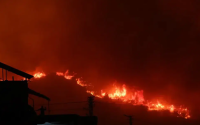11 February 2006 The Independent
The inherently chaotic nature of the Earth's weather system can be summed up by a phenomenon known as the "butterfly effect", which states that the flap of a butterfly's wing in Brazil can result in a tornado ripping through Texas.
In other words, tiny perturbations in the highly dynamic system of the weather can result in far bigger effects further down the line, even on the other side of the world.
Weather, of course, is not the same as climate. One happens day by day, the other involves long-term trends over many decades, centuries or even millennia. We remember changes in the weather, but have a weaker grasp of climate change. Yet both involve a level of chaotic complexity that poses immense problems for scientific analysis.
We know that the global climate is influenced by complex interactions between the weather systems of the oceans and those of the atmosphere. Land, too, plays its part, whether it is the effect of snow and ice reflecting sunlight - and hence heat - due to the "albedo effect", or mountain ranges that influence the direction of prevailing winds.
Scientists have also come to understand the nature of some of the "feedbacks" that can influence both the speed and the direction of climate change. Some of these are positive feedbacks, which accelerate the rate of warming, and some are negative, which tend to keep global warming in check by cooling things down.
Unfortunately it appears that positive feedbacks threaten to exert a stronger influence than the known negative feedbacks.
Perhaps we can hope that there are still some little-understood negative feedbacks that could kick in. Scientists for instance have only just understood how the winter snow in the forests of the Rocky Mountains acts like a thermal blanket, causing soil microbes to remain warm and so breathe out more carbon dioxide in the winter months.
Less snow cover actually means colder soil temperatures and hence the release of less carbon dioxide.
Nobody, least of all the climate scientists, would say we know all there is to know about climate change. And however bleak the outlook, there is still every reason we should take action now to minimise carbon dioxide emissions.
Although we can expect matters to get worse, how much worse they eventually get relies largely on what we as a global community are prepared to do now. That's why we have no time to lose.
The inherently chaotic nature of the Earth's weather system can be summed up by a phenomenon known as the "butterfly effect", which states that the flap of a butterfly's wing in Brazil can result in a tornado ripping through Texas.
In other words, tiny perturbations in the highly dynamic system of the weather can result in far bigger effects further down the line, even on the other side of the world.
Weather, of course, is not the same as climate. One happens day by day, the other involves long-term trends over many decades, centuries or even millennia. We remember changes in the weather, but have a weaker grasp of climate change. Yet both involve a level of chaotic complexity that poses immense problems for scientific analysis.
We know that the global climate is influenced by complex interactions between the weather systems of the oceans and those of the atmosphere. Land, too, plays its part, whether it is the effect of snow and ice reflecting sunlight - and hence heat - due to the "albedo effect", or mountain ranges that influence the direction of prevailing winds.
Scientists have also come to understand the nature of some of the "feedbacks" that can influence both the speed and the direction of climate change. Some of these are positive feedbacks, which accelerate the rate of warming, and some are negative, which tend to keep global warming in check by cooling things down.
Unfortunately it appears that positive feedbacks threaten to exert a stronger influence than the known negative feedbacks.
Perhaps we can hope that there are still some little-understood negative feedbacks that could kick in. Scientists for instance have only just understood how the winter snow in the forests of the Rocky Mountains acts like a thermal blanket, causing soil microbes to remain warm and so breathe out more carbon dioxide in the winter months.
Less snow cover actually means colder soil temperatures and hence the release of less carbon dioxide.
Nobody, least of all the climate scientists, would say we know all there is to know about climate change. And however bleak the outlook, there is still every reason we should take action now to minimise carbon dioxide emissions.
Although we can expect matters to get worse, how much worse they eventually get relies largely on what we as a global community are prepared to do now. That's why we have no time to lose.






